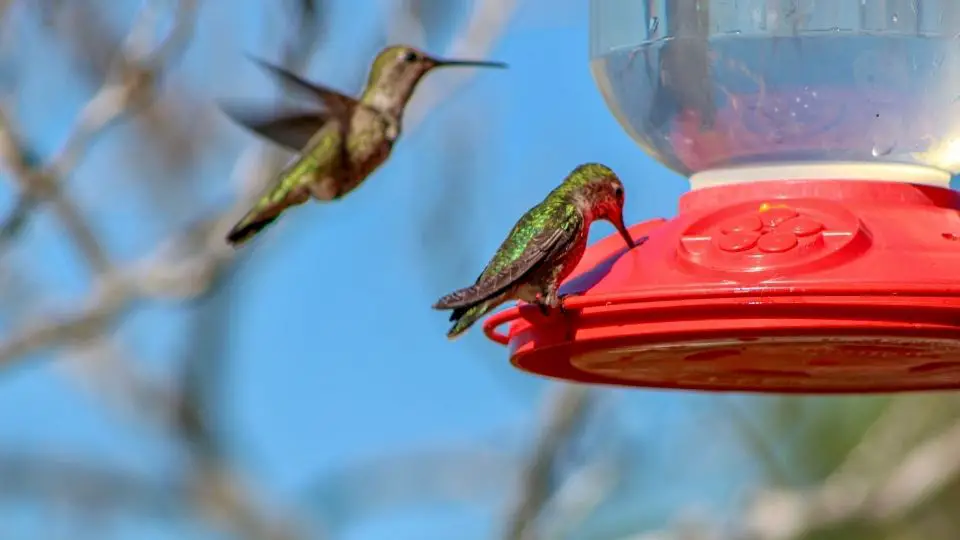Some sources estimate that the best time to put out hummingbird feeders is year-round, while others specify that the best interval is in spring. There is some contradictory information or comments on this topic, so let’s settle this once and for all.
Migrating hummingbirds will be hungry after traveling long distances, so you can give them a helping hand!
North America is filled with these beautiful hummers, so if you want to feast your eyes on their beautiful colors, it helps to know when to put the feeders out. You can make a DIY feeder or order one from Amazon.
The best time to put out feeders depends on location, hummingbird migration time, and species of hummingbird. The most recommended time is usually as early as late February - Hummingbirds start arriving mid or early spring (more specifically, late March or early April)
You can also observe and notice the first hummingbird sightings and decide according to that.
Hummingbirds are migrants – when spring migration starts, male hummingbirds are the first to arrive, with female hummingbirds arriving a couple of weeks later.

Table of Contents
Feeding hummingbirds
Hummingbird food
Hummingbirds’ primary nectar source comes from tubular flowers that are just perfect for their long tongue, but they also munch on other things like small insects, tree sap, larvae, and insect eggs.
Sugar water or (homemade nectar) is usually the go-to option for people to put in their garden – it’s the easiest way to attract hummers all around. But you can also plant flowers if you want them to stick around.
The recipe for nectar is 4 parts water to 1 part sugar.
When can you put out hummingbird feeders?
We’re going to focus on hummingbird feeders in this article. Let’s see what time of year is best to put your bird feeders out!
According to location and species of hummingbirds:
Alabama – the beginning of March; Ruby-throated Hummingbirds are natives; visited by Rufous hummingbirds and Black-chinned hummingbirds.
Alaska – beginning of April; Rufous hummingbirds are most common.
Arizona – Year-round; Rivoli’s hummingbirds are year-round residents
Arkansas – middle of March; visited by Ruby-throated hummingbirds.
California – Year-round; Costa’s hummingbirds and Anna’s hummingbirds are residents; visited by Allen’s, Calliope, Rufous, and Black-chinned hummingbirds.
Colorado – at the beginning of April; Rufous, Broad-tailed, Black-chinned, and Calliope hummingbirds.
Connecticut – beginning of April; visited by Rufous and Ruby-throated
Delaware – beginning of April; visited by Ruby-throated
Florida – Year-round; Ruby-throated hummingbirds are residents
Georgia – Year-round; visited by Rufous and Ruby-throated hummingbirds.
Idaho – end of March; visited by Black-Chinned, Anna’s, Broad-tailed, Rufous, and Calliope hummingbirds

Illinois – beginning of April; visited by Ruby-throated hummingbirds
Indiana – beginning of April; visited by Ruby-throated hummingbirds
Iowa – middle of April; visited by Ruby-throated hummingbirds
Kansas – beginning of April; visited by Ruby-throated and Rufous hummingbirds.
Kentucky – in the middle of March; visited by Ruby-throated and Rufous hummingbirds.
Louisiana – Year-round; residents: Black-chinned, Calliope, Broad-tailed, Rufous, and Buff-bellied hummingbirds; visited by Ruby-throated
Maine – middle of April; visited by Ruby-throated.
Maryland – beginning of April; visited by Ruby-throated, Rufous hummingbirds are residents.
Massachusetts – beginning of April; visited by Ruby-throated hummingbirds
Michigan – beginning of April; visited by Ruby-throated hummingbirds
Minnesota – middle of April; visited by Ruby-throated hummingbirds
Mississippi – Year-round; visited by Ruby-throated hummingbirds
Missouri – beginning of March; visited by Ruby-throated hummingbirds

Montana – beginning of April; Broad-tailed, Rufous, Black-chinned, Calliope, and Ruby-throated hummingbirds.
Nebraska – middle of April; visited by Ruby-throated hummingbirds
Nevada – beginning of March; visited by Black-chinned, Broad-tailed and Rufous, and Calliope hummingbirds; Costa’s and Anna’s hummingbirds are residents.
New Hampshire – beginning of April; visited by Ruby-throated hummingbirds.
New Jersey – in the middle of March; visited by Ruby-throated hummingbirds.
New Mexico – end of February; visited by Black-chinned, Broad-tailed, Rufous, and Calliope hummingbirds
New York – at the end of March; visited by Ruby-throated hummingbirds.
North Carolina – Year-round; Ruby-throated hummingbirds.
North Dakota – at the end of April; visited by Ruby-throated hummingbirds.
Ohio – at the end of March; visited by Ruby-throated hummingbirds.
Oklahoma – at the end of March; visited by Ruby-throated, Rufous, and Black-chinned hummingbirds.
Oregon – Year-round; Allen’s, Rufous, Black-chinned, and Calliope hummingbirds.
Pennsylvania – at the end of March; visited by Ruby-throated hummingbirds.
Rhode Island – at the beginning of April; visited by Ruby-throated hummingbirds.
South Carolina – beginning of March; visited by Ruby-throated and Rufous hummingbirds.
South Dakota – at the end of April; visited by Ruby-throated, Broad-tailed, and Rufous hummingbirds.
Tennessee – end of March; visited by Ruby-throated hummingbirds.
Texas – Year-round; Lucifer, Ruby-throated, and Black-chinned hummingbirds.
Utah – in the middle of March; visited by Rufous, Black-chinned, Broad-tailed, and Calliope hummingbirds.
Vermont – beginning of April; visited by Ruby-throated hummingbirds.
Virginia – beginning of March; visited by Ruby-throated hummingbirds.
Washington – at the end of March; visited by Black-chinned, Rufous, and Calliope hummingbirds.
West Virginia – in the middle of March; visited by Ruby-throated and Rufous hummingbirds.
Wisconsin – at the beginning of April; visited by Ruby-throated hummingbirds.
Wyoming – at the end of April; visited by Calliope, Black-chinned, Broad-tailed, and Rufous hummingbirds.
Hummingbird feeders tips
After putting the hummer feeders out, keep an eye on them and change the hummingbird nectar every time the feeder gets messy.
Put more food sources for hummingbirds. Other than feeders, you can plant tubular flowers and trees in your garden. That way, they can have access to natural nectar and tree sap.
As you could probably tell, hummingbirds love having red-colored things around. You can put a ribbon on feeders to attract them. Make sure not to use red dye, as it can be toxic for hummers.
Putting your feeders near perches ensures hummers will come to visit more frequently.

